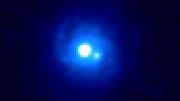
An artist’s conception of a blazar, a galay powered by an active nucleus. Blazars are the most common sources detected by NASA’s Fermi gamma-ray spacecraft. Astronomers have modeled the bright, variable emission from the blazar CTA102 between 2013-2017 using data taken from the gamma-ray to radio bands. They are able to explain the multi-wavelength variability observed using a geometrical model for the rapidly moving jets. Credit: M. Weiss/CfA
Active galactic nuclei (AGN) are supermassive black holes at the centers of galaxies that are accreting material. These AGN emit jets of charged particles that move at speeds close to that of light, transporting huge amounts of energy away from the central black hole region and radiating across the electromagnetic spectrum. Blazars are extreme examples of AGN in which the collimated jets are coincidentally aligned towards us. Blazar jets have two peak emission wavelengths, one that spans the range from the radio to the X-ray, the result of charged particle acceleration, and one at extremely short wavelength, high energy gamma ray bands usually (and somewhat controversially) attributed to the charged particles scattering infrared “seed” photons from a variety of other sources. All these bands manifest strong and unpredictable variability. Simultaneous, long-term observations across multiple bands therefore, by modeling the relative timing of flares and other variable emission, offer a valuable way to investigate the numerous possible physical mechanisms at work.
CfA astronomer Mark Gurwell was a member of a large team of astronomers that monitored variability of the blazar CTA102 from 2013-2017 spanning the electromagnetic spectrum from radio to gamma rays, in particular using the Submillimeter Array to measure crucial short (mm/submm) wavelength radio emission. Although this bright blazar had been under surveillance since 1978, it was only since the launch of the Compton Gamma Ray Observatory in 1992 that its gamma-ray variability was discovered, and the launch of the Fermi Gamma-Ray Space Telescope mission 2008 enabled continued observations.
In 2016, CTA102 entered a new phase of very high gamma-ray activity, flaring for a few weeks with corresponding emission changes at all wavelengths. In December of that year a flare was spotted that was more than 250 times brighter than its usual faint state. Several detailed physical scenarios were proposed for that event, one of them based on changes in the geometrical orientation of the jets. In the new paper, the team notes that because the two emission peaks arise from two different processes with different geometrical characteristics, the geometrical scenario can be tested. The gamma-ray and optical fluxes arise from the same particle motions in the jets, for example, and should be strongly correlated. The astronomers undertook an analysis of all the available variability data from 2013-2017. They conclude that an inhomogeneous, curved jet modulated by changes in orientation can explain the long-term flux and spectral evolution of CTA102 in a straightforward way.
Reference: “Investigating the Multiwavelength Behaviour of the Flat Spectrum Radio Quasar CTA 102 during 2013–2017” by F D’Ammando, C M Raiteri, M Villata, J A Acosta-Pulido, I Agudo, A A Arkharov, R Bachev, G V Baida, E Benítez, G A Borman, W Boschin, V Bozhilov, M S Butuzova, P Calcidese, M I Carnerero, D Carosati, C Casadio, N Castro-Segura, W-P Chen, G Damljanovic, A Di Paola, J Echevarría, N V Efimova, Sh A Ehgamberdiev, C Espinosa, A Fuentes, A Giunta, J L Gómez, T S Grishina, M A Gurwell, D Hiriart, H Jermak, B Jordan, S G Jorstad, M Joshi, G N Kimeridze, E N Kopatskaya, K Kuratov, O M Kurtanidze, S O Kurtanidze, A Lähteenmäki, V M Larionov, E G Larionova, L V Larionova, C Lázaro, C S Lin, M P Malmrose, A P Marscher, K Matsumoto, B McBreen, R Michel, B Mihov, M Minev, D O Mirzaqulov, S N Molina, J W Moody, D A Morozova, S V Nazarov, A A Nikiforova, M G Nikolashvili, J M Ohlert, N Okhmat, E Ovcharov, F Pinna, T A Polakis, C Protasio, T Pursimo, F J Redondo-Lorenzo, N Rizzi, G Rodriguez-Coira, K Sadakane, A C Sadun, M R Samal, S S Savchenko, E Semkov, L Sigua, B A Skiff, L Slavcheva-Mihova, P S Smith, I A Steele, A Strigachev, J Tammi, C Thum, M Tornikoski, Yu V Troitskaya, I S Troitsky, A A Vasilyev, O Vince, (the WEBT Collaboration), T Hovatta, S Kiehlmann, W Max-Moerbeck, A C S Readhead, R Reeves, T J Pearson, (the OVRO Team), T Mufakharov, Yu V Sotnikova and M G Mingaliev, 9 October 2019, Monthly Notices of the Royal Astronomical Society.
DOI: 10.1093/mnras/stz2792









“Active galactic nuclei (AGN) are supermassive black holes at the centers of galaxies that are accreting material.”
Again, is there anything that black holes can’t do? They’re the perfect solution to whatever you need to save all the crazy theories in astrophysics today. But again, please explain to me how black holes on the one hand gobble up everything near them so that nothing escapes their gravity well, and yet on the other hand they ALSO accrete material, as in “jets of charged particles that move at speeds close to that of light, transporting huge amounts of energy away from the central black hole region and radiating across the electromagnetic spectrum.” This is an internally contradictory proposition, yet this contradiction seems to be totally ignored and basically the stance is, well, black holes can just do that. Again, this is totally bogus non-scientific hokum.